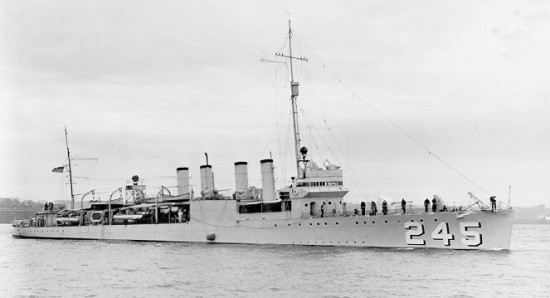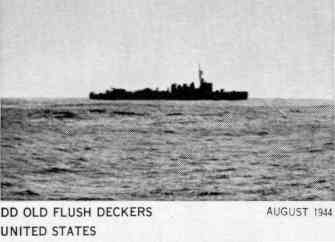Fighting the U-boats
Allied Navies
Destroyers
Flush Deck

The "four-piper" USS Reuben James DD-245 of the Clemens class of 1919. She was torpedoed and sunk by Erich Topp's U-552 on 31 Oct, 1941.
81 built
| Displacement | 1100 tons |
| Complement | 150 |
| Armament |
4 low angle 4"/50 & one high angle 3"/50 Depth charge throwers 4 3x21" torpedo tubes |
| Detection | ASDIC, Radar and HF/DF |
| Max speed | 35 knots |
"Flush Deck" was the term used to differentiate United States destroyers mass produced during the first world war from destroyers built between the wars. In addition to those listed here, several had been converted to various auxilliaries. Another fifty had been given to England in exchange for military bases in British colonies. The Royal Navy identified their acquisitions as the TOWN class.
By 1941 United States flush deck destoyers escorted convoys through the western Atlantic "Neutrality Zone" and identical Royal Navy Town class destroyers escorted the convoy through the eastern Atlantic to England. A ship's silhouette viewed through a U-boat periscope (or against the aurora borealis of the night sky) was of little use to determine the destroyer's nationality. Under these circumstances, U-652 and USS Greer ineffectually exchanged torpedoes and depth charges on 4 September 1941, 3 months prior to declaration of war.
Six weeks later USS Reuben James became the first US warship loss of a war the United States had not yet declared. The Pacific conflict and vulnerability of United States Atlantic coastal shipping reduced the number of flush deck destroyers escorting trans-Atlantic convoys in 1942. A few flush deck destroyers remained near Iceland to augment escort of threatened convoys, but the United States Navy seldom matched the Royal Navy's standard of seamanship in the higher latitudes; and flush deck destroyers (or their crews) seemed more effective in warmer waters.
-
Chew (DD-106), Crane (DD-109), Breckinridge (DD-148),
Barney (DD-149), Blakeley (DD-150), Biddle (DD-151),
King (DD-242), Goff (DD-247), and Lawrence (DD-250).
This group of ships formed the destroyer squadron of the United States Asiatic Fleet based at Manila. These destroyers fought a retreating action during Japanese conquest of the Philippines and the Dutch East Indies. The names of destroyers lost in the defense of Java were given to destroyer escorts launched a few months later, and may confuse historians.
-
Alden (DD-211), Barker (DD-213), John D Edwards (DD-216),
Whipple (DD-217), Parrott (DD-218), Edsall (DD-219),
Bulmer (DD-222), Stewart (DD-224), Pope (DD-225),
Peary (DD-226), Pillsbury (DD-227), John D Ford (DD-228),
and Paul Jones (DD-230).
Most of the flush deck destroyers on the remainder of this page were rearmed during overhaul. The aftermost of the original "four stacks" was removed, and the remaining three were shortened to generate this profile from a US Navy recognition card produced by the USN Bureau of Aeronautics:

The low angle guns were replaced by high angle 3"/50 guns (some of the old 4"/50 guns were mounted on merchant ships) and two of the triple torpedo tubes were removed. Revised armament was typically six 3"/50, two 20mm and two triple torpedo tubes.
-
Lea (DD-118), Badger (DD-126), Babbitt (DD-128)
Jacob Jones (DD-130), Tarbell (DD-142), Upshur (DD-144)
Greer (DD-145), Bernadou (DD-153), Ellis (DD-154),
Cole (DD-155), Leary (DD-158), Dahlgren (DD-187),
Dallas (DD-199), Broome (DD-210), Borie (DD-215),
Simpson (DD-221), McCormick (DD-223), Truxton (DD-229),
Sturtevant (DD-240), Reuben James (DD-245),
Bainbridge (DD-246), Litchfield (DD-336),
and Decatur (DD-341).
In late 1942 these destroyers were converted to high speed troop
transports for amphibious invasions:
Talbot (DD-114 to APD-7), Waters (DD-115 to APD-8),
Dent (DD-116 to APD-9), Brooks (DD-232 to APD-10),
Gilmer (DD-233 to APD-11), Humphreys (DD-236 to APD-12),
Sands (DD-243 to APD-13), Schley (DD-103 to APD-14),
Kilty (DD-137 to APD-15), Ward (DD-139 to APD-16),
Crosby (DD-164 to APD-17), and Kane (DD-235 to APD-18).
These destroyers were similarly converted in late 1943:
Tattnall (DD-125 to APD-19), Roper (DD-147 to APD-20),
Dickerson (DD-157 to APD-21), Herbert (DD-160 to APD-22)
Overton (DD-239 to APD-23), Noa (DD-343 to APD-24),
Rathburne (DD-113 to APD-25), and Barry (DD-248 to APD-29).
These destroyers had been converted to seaplane tenders between the wars. All armament had been removed except two 3"/50 high angle guns. They were reclassified as destroyers with their original numbers when newly constructed seaplane tenders became available in November 1943. In mid-1944 some were converted again to high speed troop transports.
-
Clemson (AVD-4 to DD-186 to APD-31),
Goldsborough (AVD-5 to DD-188 to APD-32),
George E Badger (AVD-3 to DD-196 to APD-33),
McFarland (AVD-14 to DD-237), Williamson (AVD-2 to DD-244),
Belknap (AVD-8 to DD-251 to APD-34),
Osmond Ingham (AVD-9 to DD-255 to APD-35),
Greene (AVD-13 to DD-266 to APD-36), and
Hulbert (AVD-6 to DD-342).
These destroyers were retired to training duty in late 1944:
DuPont (DD-152), J Fred Talbott (DD-156), Schenck (DD-159),
Kennison (DD-138), Hatfield (DD-231), Fox (DD-234), and
MacLeish (DD-220).
U-boats sunk by US flush deck destroyers (at least partial credit):
U-85,
U-172,
U-405,
U-613 and
U-645
US Flush Deck destroyers lost to U-boats
| USS Reuben James | 17 Oct, 1941 | U-552 | |
| USS Jacob Jones | 28 Feb, 1942 | U-578 | |
| USS Borie | 1 Nov, 1943 | U-405 | |
| USS Leary | 24 Dec, 1943 | U-382 |


